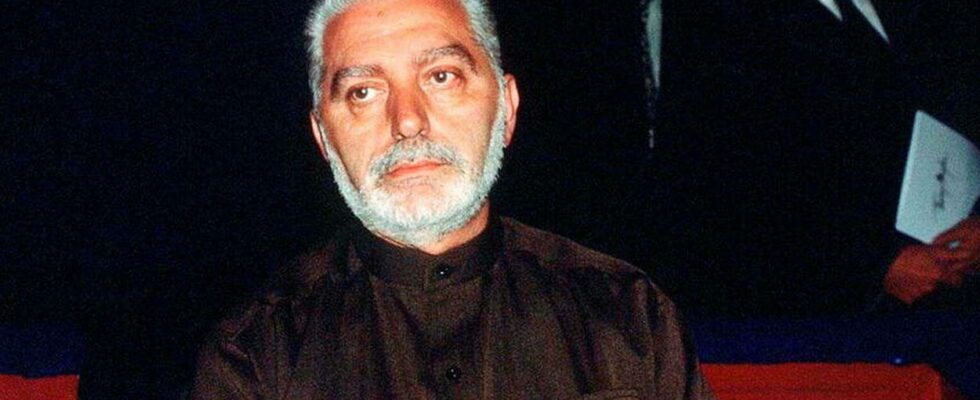Self-taught, visionary and eccentric couturier, Paco Rabanne died in 88 years. A representative of the Space Age, he was successful in the 1960s.
By Astrid Faguer
Published on
Subscriber-only audio playback
” VSHe’s not a designer, he’s a metallurgist! said Coco Chanel of him. And for good reason, Paco Rabanne, whose brand has confirmed Point this Friday, February 3, death at 88 years old, introduced industrial materials into its collections in 1966. At the age of 32, in the salons of the Hôtel George-V, he presented his first haute couture opus called “Manifeste”, composed of “12 importable dresses in contemporary materials”. His experimental creations, adorned with sequins, aluminum and rhodoïd plates, are worn by barefoot models who parade to the jerky rhythm of Pierre Boulez’s “Marteau sans maître” – something rare at a time when there are still the barkers who enliven the fashion shows.
Born in 1934 in Pasaia (in the Spanish Basque Country), the young Francisco Rabaneda y Cuervo (his real name) fled the Spanish Civil War with his mother – first hand at Cristobal Balenciaga, then established in San Sebastian. His father, an officer, was assassinated in 1936 by Franco’s armies. Arriving in Morlaix at the age of 5, he left Brittany in 1951 to study architecture at the École Nationale Supérieure des Beaux-Arts in Paris – studies which he financed by making fashion sketches (in particular shoe designs for Charles Jourdan), then becoming a props designer for major fashion houses (Nina Ricci, Balenciaga, Pierre Cardin, etc.).
BB, Jane Fonda Francoise Hardy
In 1959, he published his first fashion designs in the American newspaper Women’s Wear Daily under the name of Franck Rabanne, before definitively choosing the pseudonym of Paco Rabanne. It was with this new identity that he launched, in 1965, the “Pacotilles” – accessories in rhodoid (earrings and glasses) in partnership with Emmanuelle Khanh –, then officially founded his eponymous brand in 1966. His singular creations – starting with his chain mail-style dresses – quickly attracted all eyes. Just like his happening-like parades which are set out far from the very codified presentations of the time.
Note that with Yves Saint Laurent, he is one of the first to parade models with black skin. The stars of the time were seduced by the modernity of the subject. Anouk Aimée, Françoise Hardy or even Brigitte Bardot acclaim the brand. Paco Rabanne also collaborates with the film industry. We remember Jane Fonda cast in her metallic costume for the film Barbarella (1968) in front of Roger Vadim’s camera – a piece now held at MoMA in New York.
In experimental mode
Proof is made that metalwork and glamor can rhyme. However, supporters of more traditional fashion do not understand this wardrobe, which they consider too heavy and uncomfortable (some dresses can weigh up to 8 kilos). Regardless, Paco Rabanne continues to experiment and innovate (fluorescent models, in molded plastic, in orange reflectors, others made of slide covers and kit wedding dresses) and diversifies in parallel, between debut in perfumery (in association with the Catalan group Puig) and launch of men’s and women’s ready-to-wear.
Success is there: the juices are snapped up – starting with Calandre, then XS and Paco, before One Million – and the creator, who describes himself more as an artisan, is rewarded with a gold die for his spring-summer haute couture collection in 1990. From 1999, he gradually withdrew from the catwalks, leaving first haute couture, then ready-to-wear – the brand continues its work today under the leadership of Breton designer Julien Dossena. Passionate about occult sciences, it is on another ground that the couturier will then be talked about.
fashion nostradamus
Multiplying the appearances on television sets to tell the story of his past lives, he will announce in turn the crash of the MIR space station in Paris and the apocalypse in the south-west of France scheduled for August 11, 1999 at 11 h 22. So many false predictions, repeated in his book fire from heaven (1999), which will subsequently encourage him to media discretion. Often quoted by a galaxy of designers who came after him (Martin Margiela in the lead), it must be recognized that Paco Rabanne was nonetheless a visionary in the field of fashion: between the practice of upcycling before its time, the diversity of castings and parades thought of as performances.
